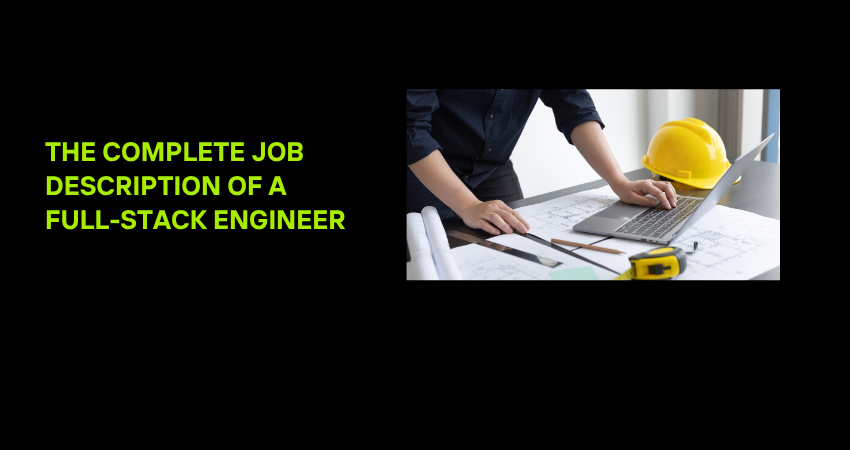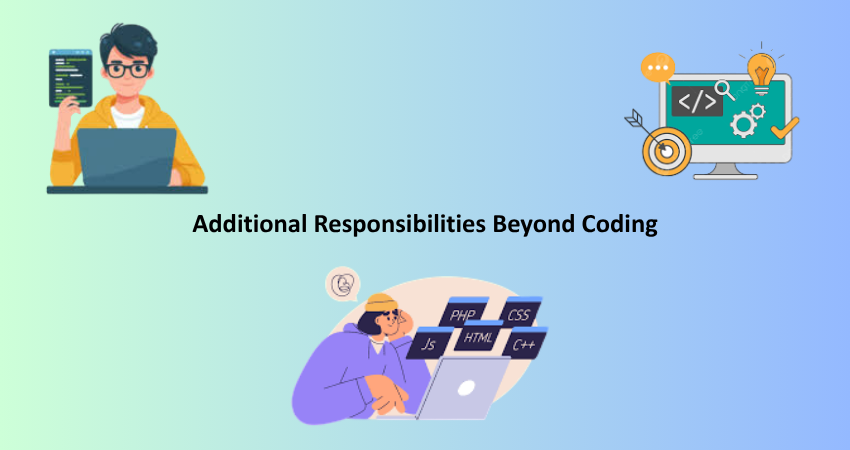
Introduction
The last decade has seen the technology arena steadily take on new shapes and forms, thereby encouraging a wide range of specialized professions. Arguably one of the “most energetic and sought-after” posts you would find today in Web and Software Development, that of a Full-Stack Engineer. Full-Stack Engineers are expected to handle everything, from front-end development to back-end development, while easing companies’ burden with agile development cycles and cross-team communication, as well as possible integrations into the product. Full stack engineers transform business logic into working systems that manage human operations for both start-ups and enterprise-level consolidated corporations.
The entire job description for full stack engineer will be discussed in this article covering every important responsibility, skill requirement, and expectation associated with the same. A detailed breakdown of their duties-from working on client facing interface development to working on database and server sidelogic-will reveal the unending dynamics of the job. Each section looks into greater detail about the tools they use, the problems they solve, and the value they bring to their teams. Whether you want to be one or want to hire one, knowing the entire realm of this role will put you in a better position to capitalize on it.
Understanding the Role of a Full-Stack Engineer
What Does a Full-Stack Engineer Do?
A Full-Stack Engineer is a software specialist who possesses both front-end (client-side) and back-end (server-side) technologies. With this specialized training, they are capable of working on software applications from initial concepts to deployment, maintenance, and possible future enhancements. Full-stack engineers work with HTML, CSS, and JavaScript frameworks like React, Angular, and Vue.js to build the interactive front end, that is not only visually appealing but also must offer the best user experience by observing tenets of design, such as accessibility, responsiveness, and usability.
Backend engineers are those who manage database and application logic that makes possible an application. They typically write server-side code with relational APIs that interact with front-end clients using secure connections in a language such as Python, Node.js, Ruby, Java or PHP. Working with databases such as MySQL, MongoDB, or PostgreSQL, they ensure that data is stored efficiently and securely. This end-to-end knowledge makes full-stack engineers most valuable in an agile environment where speed and flexibility are essential. Additionally, they provide the link between design and front-end development and back-end engineering, easing the pain of communication and implementation.
Why Companies Value Full-Stack Engineers
Full-stack engineers are really well appreciated nowadays by many companies because of their use and affordability compared to hiring multiple specialized employees. Why hire an employee who works on each layer of the tech stack when one can simply afford to hire a full-stack engineer? This option is especially common in small teams or companies whose talent resources are less than they would like. Full-stack engineers are also available as solutions that cover the entire process, thereby saving time on travel between teams.
They know the whole software ecosystem, and this helps them convey business needs into technical requirements. Features can be owned by them from ideation to release, thereby cutting down the delays in handoff that hinder development in siloed teams. Full-stack engineers act as utility players in large enterprises, filling in gaps whenever front-end or back-end teams run into bottlenecks. Full-stack engineers are strategic assets in today’s fast-paced tech environment, as they are able to see all angles, optimize performance, delay-taking solutions to test beyond their scope, and troubleshoot tough problems.
Core Front-End Responsibilities

Designing and Building User Interfaces
The other main duty of a full-stack engineer is to design interfaces that are striking and easy for the user to navigate on the front end. Lay the framework using HTML/CSS; introduce interactivity via JavaScript; and add dynamic behavior via one of many frameworks, such as React or Vue.js. Full-stack engineers should also be mindful of user accessibility, responsiveness on varying devices, and cross-browser app compatibility. Weirdly, it is their work that brings polish to the users’ experience, making it visual and much smoother, intuitive, and functional across platforms.
These engineers should have firm design principles and usability. They may not replace the efforts of UI/UX designers, but, they must know how to implement wireframes and prototypes correctly. They quite frequently work with designers to convert mockups into code, all while making sure the technical implementation does not hamper application performance and accessibility. They also control state changes for single-page applications (SPAs), operate on component libraries, and ensure that front end communication with the back end is carried out through APIs. Striking a balance between looks and functionality is essential when building on target user satisfaction.
Performance Optimization and SEO Considerations
The design in which a web page is structured brings into reality performance for front-end users for user retention, search engine ranking, and effectiveness. Full-stack engineers use the implemented best practices for the quickest and most responsive page load. Examples include reducing the size of CSS and JavaScript files by lazy loading images, using modern image types such as WebP, and effective caching mechanisms. They should also gain an appreciation of critical rendering paths and the use of browser-developers’ tools for debug and fine-tuning experiences.
SEO is yet another key area of concern for the full-stack engineer. SEO has always been an area primarily assigned to marketers, but the technical side of it carries a lot of weight. Best practices on semantic HTML markup, mobile-first, fast loading speed, and server-side rendering when necessary have to be implemented in the sites by full-stack engineers. They may also have to use Lighthouse, PageSpeed Insight, and Core Web Vitals to score and improve the SEO performance. As a result of managing these, full-stack engineers can work to increase visibility, traffic, and a smooth experience on both sides of the screen: users and crawlers.
Core Back-End Responsibilities
Developing APIs and Server-Side Logic
Backend development in any web application is concise and competent; all logic behind the app is also same, and therefore, full-stack engineers need to be skilled at writing clean, maintainable, and scalable server-side code. They often rely on one or more of the following frameworks: Express.js (for Node), Django (in Python), Spring Boot (with Java), or Laravel (in PHP) to create REST APIs and manage business logic. They serve as the bridge between the front end and the back end-ended, i.e., between a database and the actual user interface, for operations such as form submissions, data retrieval, authentication, etc.
Other duties of full-stack engineers go beyond just API building, they are responsible for the security and efficiency of the services as well. The middleware includes that required to perform request validation using OAuth or JWT, error handling as mechanisms and so on, that take care of tasks otherwise experienced by the client doing server request. These professionals should also follow some best practices, such as RESTful APIs being stateless, proper status codes, and environment variables for sensitive information. They are also responsible for testing endpoints using tools like Postman or writing unit/integration tests. All these desirable server-side characteristics will lead to developing sound, usable, and maintainable applications.
Database Management and Data Modeling
A full-stack engineer’s database skills are just as important, as any application will require storing and retrieving some item of data. In such cases schema design is expected to optimize for speed, consistency, and scalability. Now it’s time to choose between the two worlds: relational databases, such as PostgreSQL or MySQL, or NoSQL databases, including MongoDB or Redis, to predetermine the database technology to be applied depending on the data structure and use cases of the application. Understanding SQL queries, joins, and indexing and normalization for relational databases and understanding document-based storage and querying for NoSQL databases are also crucial components.
Data modeling is more than just structure-it’s also about maintaining data integrity and relationships. Full-stack engineers should understand the business logic driving the application so that they can create truly representative data models. They will also need to implement database migrations, seed initial data, and enforce security features like access controls while working against common attack vectors like SQL injection. Real-time applications such as chat applications or dashboards will also have to sync data between clients and servers through mechanisms like WebSockets or Firebase. With these duties, the back-end will run in calm waters, supporting all front-end functionalities without a hitch.
Additional Responsibilities Beyond Coding

DevOps and Deployment Practices
In smaller teams, full-stack engineers tend to spend an increasing proportion of their time on DevOps tasks, where the roles become blurry. Application configuration for deployment on cloud services like AWS, Azure, or Google Cloud, in addition to web servers like nginx, Apache; actual configuration would be understanding how to set up CI/CD pipelines with tools like Jenkins, GitHub Actions, or GitLab CI, which automate the testing and deployment process, reduce human error, and accelerate the software release cycle.
Containerization/docker image creation and Kubernetes orchestration are thus becoming de rigueur. Full-stack engineers need knowledge to build the Docker images, run and manage containers, and scale the applications in production environment. Tools for monitoring and logging such as Prometheus, Grafana, or Loggly help provide observability: should anything malfunction in production, full-stack engineers investigate, roll back changes if needed, and deploy hotfixes without interfering with the user experience. This blend of software development and system administration marks their centrality to end-to-end software delivery.
Collaboration, Communication, and Agile Methodologies
Full stack engineers don’t just do technical works; they indeed play some critical roles in team work. They will tie up with UI and UX designers in implementing user interfaces as well as would along with an API refining back end specialists, if any, and will need to work along with QA testers so as to figure through errors. Thus, effective communication would be required to coordinate these, especially in agile teams which apply a very fast-moving and iterative workflow. Quite commonly, full-stack engineers are involved in daily standups, sprint planning, retrospectives, and code reviews. Of course, they will have to get fully involved in the project goals, timelines, and how their tasks fit into the larger roadmap.
They would also work on documentation, helping new joiners transition quicker and providing uniformity across the code base. Good full stack engineers mentor junior developers and play a peer review role towards realizing coding standards. They are also expected never to be static but updated with new technologies under constantly changing environments requiring experimentation with new exciting tool or framework that would boost their productivity or that of their team. The multi-hatted nature of developer, collaborator, and strategist makes them very valuable in a purposed, evolving environment.
Conclusion
The role of full-stack engineer entails varied duties from front-end to back-end development in software and web development. Full-stack engineers from user interface designers to database managers, application deployers, and inter-team collaborators-they bring a holistic toolkit and are therefore immensely valuable to any tech setting. Their knowledge of the whole spectrum allows them to participate in every phase of the development process meaningfully; thus, producing cohesive, high-performing applications.
As companies become more focused on speed, agility, and digital transformation, it does not seem that the demand for this profile-so full-stack engineer-is going to slow down, at least in the immediate future. For ambitious developers, the way to become a full-stack engineer is quite a rewarding career path and gives one the capability to shape a product from the idea stage right through to implementation. For employers, this means better investing in full-stack talent is the way to go because it results in teams that are adaptive, collaborative, and proficient in technology in all its forms. A thorough understanding of this role empowers organizations and people to make rational decisions about their long-term growth and innovation.